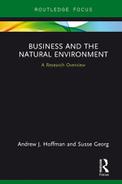5 Conclusion
B&NE research has established more than a 20-year foundation of scholarly output, with trajectories showing an upward trend until the late 2000s (see figure 2.1) followed by a plateau (see figures 2.4–2.6). As we look to the future, we can expect continued work within both the mainstream literature and the specialty journals, and on both existing research streams as well as new and contradictory streams. This duality of being both on the “inside” and on the “outside” is critical to the growth and vitality of the field. It represents a healthy tension of focusing on environmental issues within the existing models, theories and paradigms of “normal science” (Kuhn, 1970) to contribute to the field while also stepping outside the domains of existing theory to fully capture the magnitude and scope of the problem we face by pushing “the literature to ask the ‘big’ questions and push beyond the existing paradigm” (Hoffman and Bansal, 2012: 21) that are built on a model of “revolutionary” science (Kuhn, 1970).
Certainly there is a need for both. The first helps to bring existing theories into more close alignment with biophysical reality and seeks to mitigate the impact we are having on the environment. It also helps scholars to succeed and, in turn, become themselves “sustainable” (and maintain legitimacy within the academy through publication, promotion and tenure) by building upon the models and theories of the academic craft with rigorous analysis. The second recognizes that, despite the growing research on environmental issues, the environment continues to worsen with growing concerns for climate change, water depletion, species extinction, habitat destruction and a recognition of the Anthropocene. The complexity, uncertainty and ambiguity of which justifies a more pronounced engagement of B&NE research. This focus will re-energize and re-radicalize the field (Gladwin, 2012; Starik and Kanashiro, 2013), returning to the more critical tone of B&NE research from 20 years ago, when scholars of environmental issues resided outside of mainstream scholarship and practice by criticizing and challenging the underlying institutions of the field. Rather than merely fitting B&NE research within existing management theories and models, this new work will explore the ways in which the fundamental systems of thinking and beliefs must adapt to the present-day reality of the Anthropocene.
The goal for forward-looking B&NE scholars is to do both and in so doing, advance management theory and address the implications of the shift to the Anthropocene. As a result, B&NE research holds a special vantage point from which to examine those theories for possible alteration and adjustment in the face of an anomaly that highlights the extent to which these existing theories are no longer adequate. And in this way, B&NE research holds a critical key for invigorating and revitalizing the broader field of management research of which it is a part.
